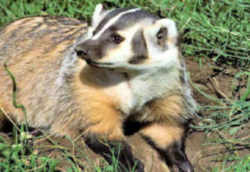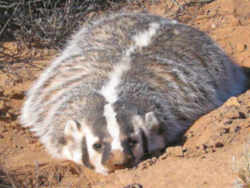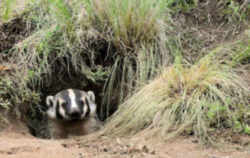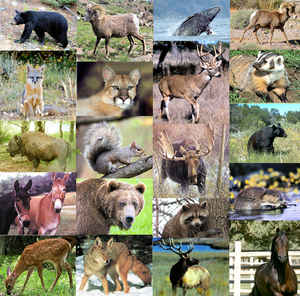Wisconsin State Animal
Badger
(Taxidea taxus)
Adopted on June 20, 1957.
The Badger, (Taxidea taxus,) was adopted on June 20, 1957 as the state animal. Wisconsin's nickname is "The Badger State" because miners dug tunnels into hillsides searching for lead in the 1800's, reminding people of badgers.
Found throughout Wisconsin, badgers are short, stocky, solitary animals with incredibly long thick claws. Badgers stay hidden inside their shallow dens during the day, hunting mostly at night for small animals found in grasslands like pocket gophers, ground squirrels, rabbits, and small birds.
Wisconsin State Animal: Badger

The American badger, a cousin of the mink and weasel, is native to the west. They are nocturnal. They are known for their aggressive behavior and the ability to dig extensive burrows.
The first European immigrants to arrive in Wisconsin found it desirable for the natural resources it offered. They began mining lead and galena to be used in shot for guns and paint. Miners who wanted to work through the winter found that the most useful shelters were their excavations. They added makeshift roofs or walls to complete them. Since these miners dig for their livelihoods and live in "burrows," they nicknamed them badgers. The term was later applied to all new settlers in the mining area and eventually to all who lived in Wisconsin
Although badgers have been associated with the coat of arms, the state flag, the University of Wisconsin, the official seal and Cornish miners since the days of the Wisconsin Territory, it was four elementary school students from Jefferson County who discovered the animal had no official status in Wisconsin.
Some northern legislators, however, wanted the white-tailed deer picked due to its strength, regal stature, and the economic value of deer hunting. In 1957 a compromise was reached, the American badger (Taxidea taxus) was named the state animal and the white-tailed deer (Odocoileus virginianus) was named the state "wildlife animal."
In 1957 a compromise was reached, the American badger (Taxidea taxus) was named the state animal and the white-tailed deer (Odocoileus virginianus)
was named the state "wildlife animal." See Section 1.10 of the statutes. In Chapter 209, Laws of 1957, it named the badger the "state animal", and
Chapter 147 designated the white-tailed deer as the state "wild-life animal".
The badgers are solitary most of the year and stay hidden inside their shallow dens during the day. They hunt mostly during the night and live in large
open fields and grasslands extending between 400 and 600 acres. You can look for signs of the badger by looking for piles of dirt outside of a large
burrow which they dig with their incredibly long thick claws. If you see a short, stocky animal with a small face staggering around in the grasslands,
it could be a badger.
Characteristics of the Badger

This muscular, grizzled, brownish gray, long haired member of the weasel family are found principally in upland grasslands, such as meadows and hayfields. Its black face is bisected by a narrow, white stripe extending to the tip of a slightly pointed black nose. This nocturnal hunting carnivore sports a short, flattened, rudder like tail and stubby legs, ending in pebbly black feet and front toes tipped with long, stout, curved, sharp nails and has a wide flat appearance. Badgers may reach 2.5 feet in length and 30 pounds in weight.
Natural History
Food Habits
The badger subsists on a diet of small mammals, birds, reptiles and arthropods. Unlike many carnivores that stalk their prey in open country, the badger catches most of its food by digging. It can tunnel after ground dwelling rodents with amazing speed.
Reproduction
The reproduction in this species is quite interesting. Although mating occurs in early autumn, embryos are arrested early in development. Embryos are held in a sort of suspended animation until December- February, when they implant into the uterine wall and resume their development. Thus, although a female is technically pregnant for 7 months, the embryos develop for a mere 6 weeks. Litters of 1-5 offspring are born in early spring. Females are able to mate when they are 4 months old, but males do not mate until the autumn of their second year.
Behavior
Badgers are solitary animals. Typical population density is about 5 animals per square kilometer. Males occupy larger home ranges than females (2.4
versus 1.6 square kilometers), but this species is not known to defend an exclusive territory. Badgers are mainly active at night, and tend to be inactive
during the winter months. The badger is an excellent digging machine. Its powerfully built forelimbs allow it to tunnel rapidly through the soil, and
apparently through other harder substances as well. There are anecdotal accounts of badgers emerging from holes they have excavated through blacktopped
pavement and two inch thick concrete.
In soft soils, adults use their claws and teeth to move aside obstacles like a steam shovel, digging themselves into the ground and out of sight in
a few minutes. Their dens may occupy old enlarged fox, coyote or woodchuck holes or newly dug, deep burrows up to 60 feet long.
Badgers prefer hunting in grassy openings. They consume a variety of prey such as mice, voles, chipmunks, ground squirrels, skunks, snakes, eggs and ground nesting birds. Carrion rounds out their diet. Some kills may be buried for later consumption.
When challenged or frightened, they will release a musky, skunk like scent. Courageous and territorial, badgers will attack if cornered. Other predators have difficulty grabbing this strong animal because it has a set of dense muscles forming a hidden protective collar around its neck and throat.
Habitat
Badgers are found principally in dry, open country.
Wisconsin Law
The law designating the badger as the official Wisconsin state animal is found in the Wisconsin Statutes, Chapter 1, Section 1.10(3)(H)
CHAPTER 1. SOVEREIGNTY AND JURISDICTION OF THE STATE.
1.10. State song, state ballad, state waltz, state dance, and state symbols.
1.10(3) The Wisconsin state symbols are as follows:
1.10(3)(a)
(a) The mourning dove (zenaidura macroura corolinensis linnaus) is the symbol of peace.
1.10(3)(b)
(b) Milk is the state beverage.
1.10(3)(c)
(c) The sugar maple (acer saccharum) is the state tree.
1.10(3)(d)
(d) Corn (Zea mays) is the state grain.
1.10(3)(e)
(e) The wood violet (viola papilionacea) is the state flower.
1.10(3)(f)
(f) The robin (turdus migratorius) is the state bird.
1.10(3)(g)
(g) The muskellunge (Esox masquinongy masquinongy Mitchell) is the state fish.
1.10(3)(h)
(h) The badger (taxidea taxus) is the state animal.
1.10(3)(i)
(i) The dairy cow (bos taurus) is the state domestic animal.
1.10(3)(j)
(j) The white-tailed deer (odocoileus virginianus) is the state wildlife animal.
1.10(3)(k)
(k) The American water spaniel is the state dog.
1.10(3)(L)
(L) The honey bee (apis mellifera) is the state insect.
1.10(3)(m)
(m) The trilobite (calymene celebra) is the state fossil.
1.10(3)(n)
(n) Galena (lead sulfide) is the state mineral.
1.10(3)(o)
(o) Red granite is the state rock
1.10(3)(p)
(p) Antigo silt loam (typic glossoboralf) is the state soil.
1.10(3)(r)
(r) The cranberry (vaccinium macrocarpon) is the state fruit.
Taxonomic Hierarchy: Badger
Kingdom: Animalia
Phylum: Chordata
Class: Mammalia
Order: Carnivora
Family: Mustelidae
Subfamily: Taxideinae
Genus: Taxidea - Waterhouse, 1839
Species: T. taxus








